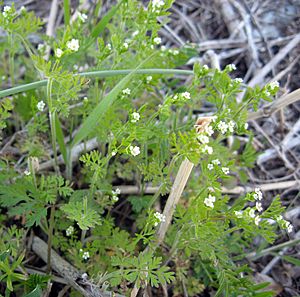Hairyfruit chervil facts for kids
Quick facts for kids Hairyfruit chervil |
|
|---|---|
 |
|
| Scientific classification | |
| Genus: |
Chaerophyllum
|
| Species: |
tainturieri
|
Chaerophyllum tainturieri is a plant known by the common names hairyfruit chervil and Southern chervil. It is an annual plant, which means it completes its entire life cycle in just one year. This plant is native to the Southeastern United States. You can also find it in Arizona and New Mexico.
Hairyfruit chervil is a common plant. It grows in open areas like glades and fields. You can also spot it in places where the ground has been disturbed, such as along roadsides or in empty lots. In the spring, it produces small clusters of white flowers that look like tiny umbrellas.
Contents
Discovering Hairyfruit Chervil
Hairyfruit chervil is a type of forb. A forb is a plant that is not a grass, sedge, or rush. It has soft stems, unlike woody plants like trees or shrubs. The scientific name for this plant is Chaerophyllum tainturieri. It was named by a famous botanist named William Jackson Hooker.
Where Does It Grow?
This plant loves the warm climate of the Southeastern United States. It is very common there. You might find it growing wild in states like Florida, Georgia, and Alabama. It also grows further west in Texas. Interestingly, there are also groups of these plants far away in Arizona and New Mexico. This shows how adaptable the plant can be!
What Does It Look Like?
Hairyfruit chervil is known for its small, delicate white flowers. These flowers grow in clusters that look like tiny umbrellas. Scientists call these clusters "umbels." The plant gets its common name, "hairyfruit chervil," from its seeds. The seeds are often covered in tiny hairs. This is a special feature that helps identify the plant.
The Life Cycle of Hairyfruit Chervil
As an annual, hairyfruit chervil has a busy life cycle. It grows from a seed, produces flowers and seeds, and then dies, all within one year.
Seed Germination
The seeds of hairyfruit chervil have a special way of waking up. Scientists studied these seeds and found something new about how they sprout. This study helped them learn more about "seed dormancy." Seed dormancy is like a deep sleep for seeds. It stops them from sprouting until the conditions are just right. This helps the plant survive tough times, like cold winters or dry spells. For hairyfruit chervil, its unique dormancy helps it sprout at the best time in spring.
Flowers and Seeds
In the spring, the plant grows its small white flowers. These flowers attract insects, which help the plant make new seeds. After the flowers fade, the plant produces its unique hairy fruits, which contain the seeds. These seeds then fall to the ground. They will wait there until the next spring to start the cycle all over again.

